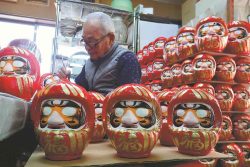
Participants write characters during a New Year’s calligraphy event at Nippon Budokan in Tokyo in January 2019.
19:47 JST, May 20, 2021
A new registration system for cultural assets will be established with the enactment of a law revision to strengthen the protection of Japanese culture, including folk festivals, cuisine, and calligraphy.
The new system is expected to help raise the profile of Japanese culture and provide a boost to various cultural fields that are suffering due to the coronavirus pandemic and a shortage of successors.
Pandemic blow
The theatrical tradition of Iwamikagura, which is said to have originated in western Shimane Prefecture, involves performers in elaborate costumes dancing to a musical accompaniment.
“As things stand now, we will not be able to continue our activities,” said Naoharu Ueoka, 76, of the performance troupe Iwamikagura Sanokagura-shachu. The group usually holds about 40 performances a year but had only four last year due to the pandemic. The situation was so bad that the troupe was not able to cover its annual operating expenses, which total more than ¥2 million.
The Diet passed an amendment to the Law for the Protection of Cultural Properties on April 16 to help protect such assets.
The aging of the population, depopulation of regional communities and the serious impact the pandemic has had on the country’s cultural fields are thought to be behind the move.
Systems to protect cultural assets include a “designation system” for national treasures and important cultural properties under which generous financial aid is available but involves strict regulations, and a “registration system” that is less restrictive and covers a broader range of fields.
Currently, the registration system covers only tangible cultural assets, such as buildings and works of art, and folk assets. Under the amended law, the registration system will also cover intangible cultural and intangible folk assets.
Intangible assets comprise performing arts and techniques that are considered to be of high historical or artistic value, such as drama, music, crafts, folk arts and cultural events.
The amended law is expected to come into force by July. The Cultural Affairs Agency intends to register about five intangible cultural properties and folk cultural properties this fiscal year.
The agency will provide subsidies totaling about ¥1.5 million to ¥2 million for each asset to cover the cost of preserving techniques and training successors.

Sake makers hope a traditional brewing technique benefits from a change in the cultural properties law.
Broader coverage
The introduction of a registration system for intangible cultural properties is also aimed at helping to invigorate regional economies and promote tourism.
“Interest from other regions and overseas will also increase. We can hope this leads to the preservation and utilization of valuable cultural assets,” Koichi Hagiuda, the minister of Education, Culture, Sports, Science and Technology, said at a press conference in February.
The new system is expected to cover a wide range of fields. A report compiled in January by a Cultural Affairs Agency panel cited not only local festivals but also traditions such as tea ceremony, flower arrangement, calligraphy, and cuisine as examples of the breadth of Japanese culture.
Various sectors have shown interest in the update to the registration system. An organization comprised of breweries was launched to hand down the techniques of sake brewing with koji mold, which is used in the fermentation process.
According to the Japan Sake and Shochu Makers Association, the shipment volume of refined sake in 2020 declined by 10% from a year earlier due to the pandemic.
“If the government recognizes the technique, it would encourage the next generation to inherit it,” an official of the association said.
Registration challenges
Tea ceremony history specialist Isao Kumakura, the director of Miho Museum in Shiga Prefecture, was also upbeat about the amendment. “While tea bowls and tea houses have been selected as national treasures and important cultural properties, the higher concept of tea ceremony has not been recognized as a national cultural property,” he said, highlighting a problem with the law as it currently stands. He said he hopes that the momentum to protect tea ceremony as a cultural asset that conveys Japanese culture will increase when the amendment takes effect.
However, establishing the criteria for registration will be a challenge. Many schools and groups exist in the fields of tea ceremony and calligraphy. “It is difficult to place one style above the others,” a member of the panel said. The same is true for food culture, which ranges from haute cuisine to regional dishes, making it challenging to evaluate as a cultural asset.
“We will take into account the status of organizations, which encompass different schools in each field,” a senior agency official said.
Cultural traditions have complex historical backgrounds and ideological differences exist within each field. As such, it may be difficult to identify such an organization in some fields.
"Society" POPULAR ARTICLE
-

M4.9 Earthquake Hits Tokyo, Neighboring Prefectures
-

Israeli Tourists Refused Accommodation at Hotel in Japan’s Nagano Pref., Prompting Protest by Israeli Embassy and Probe by Prefecture
-

M7.5 Earthquake Hits Northern Japan; Tsunami Waves Observed in Hokkaido, Aomori and Iwate Prefectures
-

Tsukiji Market Urges Tourists to Avoid Visiting in Year-End
-

High School in Kyoto Says Students Shoplifted during Recent School Trip to Bali, Indonesia
JN ACCESS RANKING
-

Tokyo Economic Security Forum to Hold Inaugural Meeting Amid Tense Global Environment
-

Keidanren Chairman Yoshinobu Tsutsui Visits Kashiwazaki-Kariwa Nuclear Power Plant; Inspects New Emergency Safety System
-

Imports of Rare Earths from China Facing Delays, May Be Caused by Deterioration of Japan-China Relations
-

University of Tokyo Professor Discusses Japanese Economic Security in Interview Ahead of Forum
-

Japan Pulls out of Vietnam Nuclear Project, Complicating Hanoi’s Power Plans

























